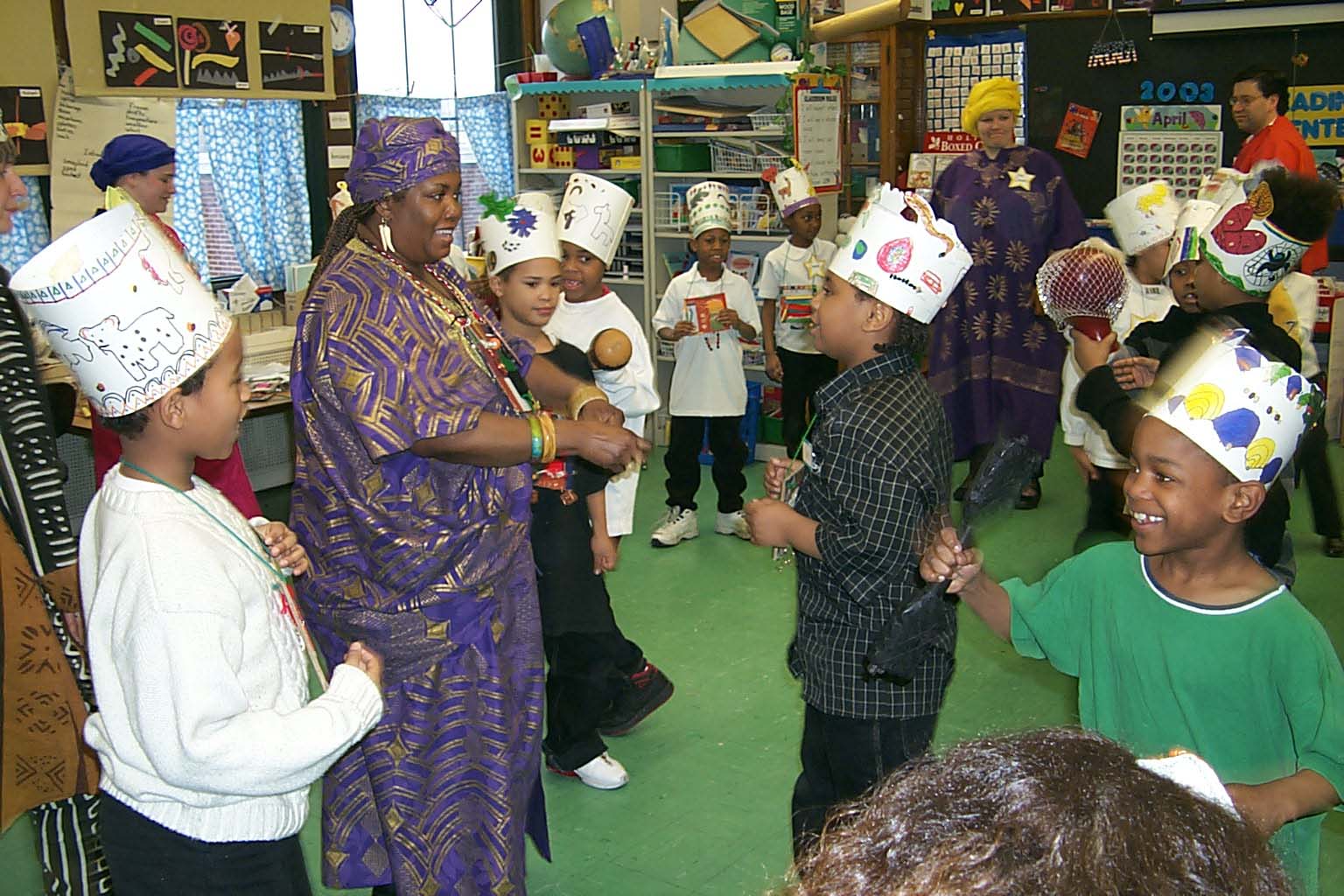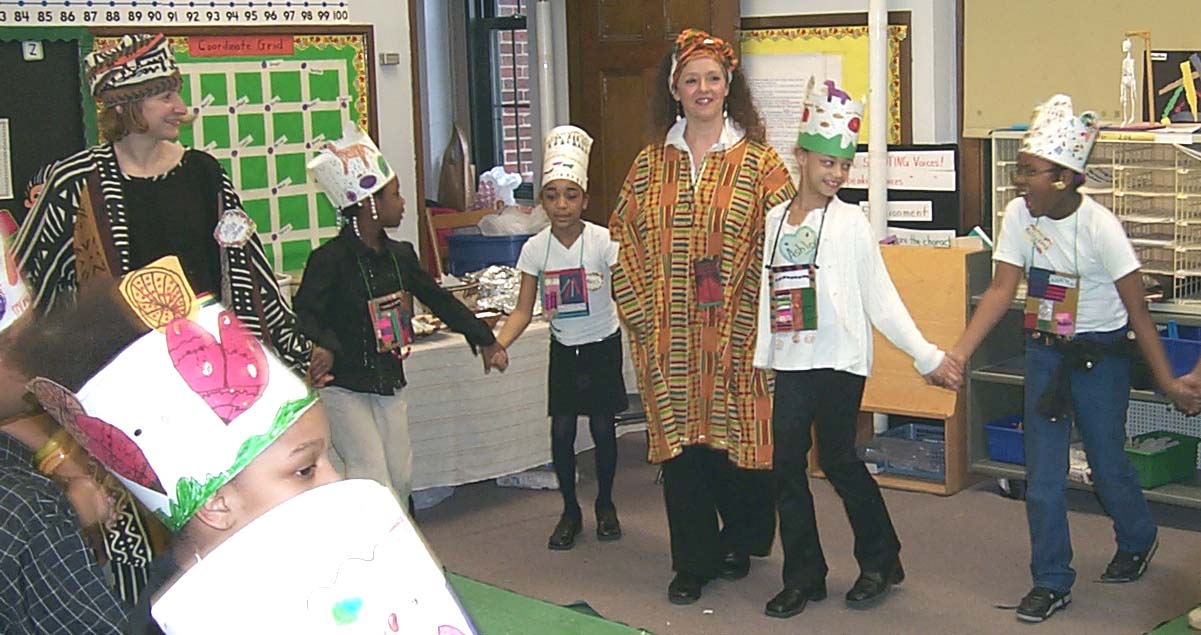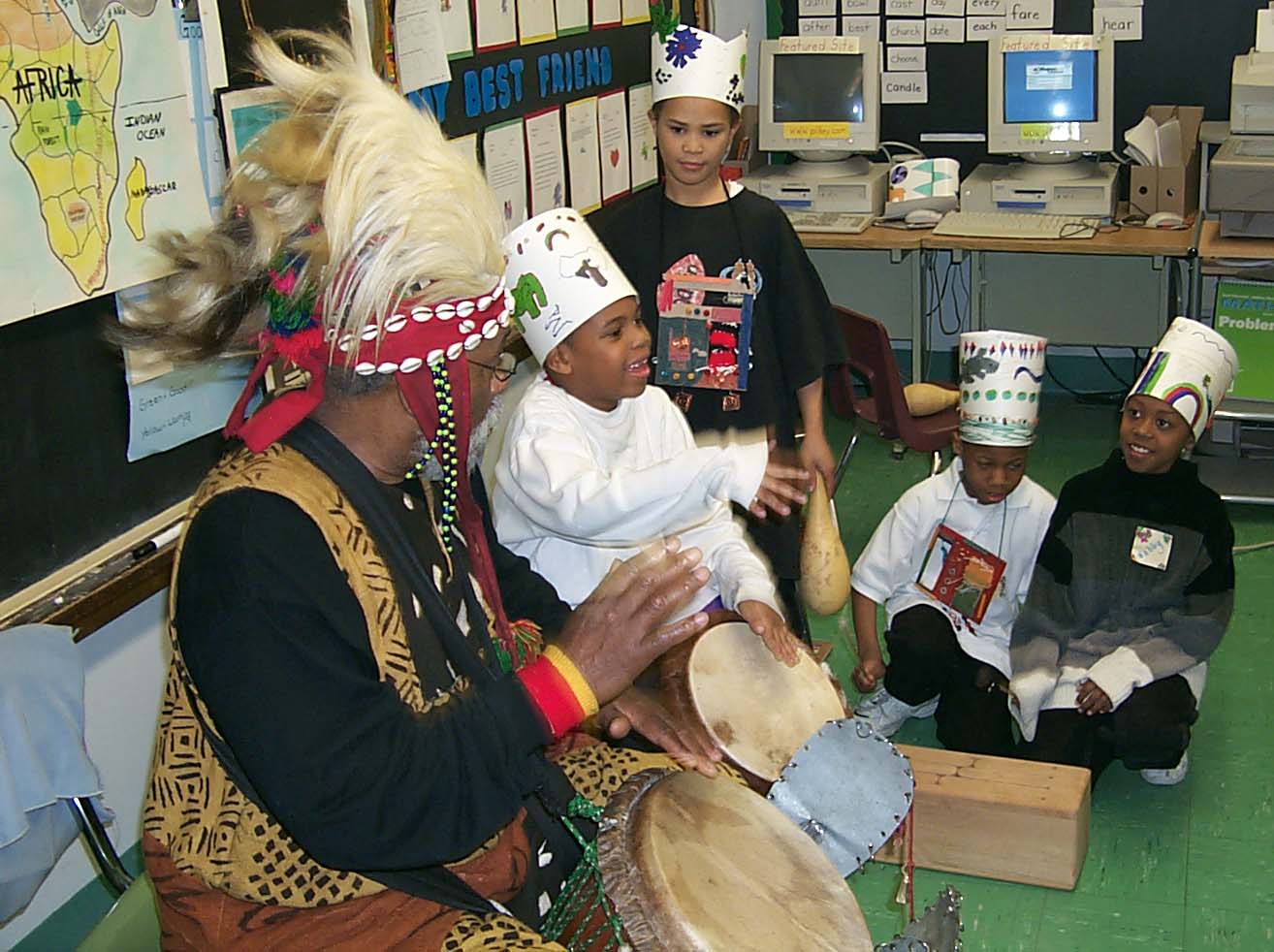Lesson Title:
Ceremony
of Honor and Celebration based on African Traditions: Singing, Dancing, Drumming,
Food. Guest Musician: Emile Latimer
Author: Lucy Andrus Grade/Age Level: Elementary
Written here for: Third Grade Inclusion Class

Conceptual Basis For This Lesson:
Unit/Theme, Relation of Lesson to the Unit, Major Concepts to be Learned:
We will begin the session by adding the oogun ashe pouches to each child’s crown in a symbolic ritual of empowerment (see previous two lessons).


Relation to Life:

Learning
Standards
Goals Specific
to Lesson/Unit (reflecting NYS standards, & targeted learning areas. See
Abbreviation Key at end):
- *see previous lessons
Tools Needed For Application
Vocabulary (defined
in age appropriate, student-friendly language):
Visuals:
- Teacher-made: Map of Africa
- Art Resources: Romare Bearden collage exemplar, Homage to Roots; Gift of the Tortoise (Sweet Honey in the Rock) audio tape; Yssou Ndour CD; artifacts and musical instruments, tongue and djambe drums; children’s crowns and breastplates
Materials:
- Boom box and music CD’s, tape
- Mirror
- Plates / Utensils / Napkins
- Hot Plate
- Crock pots
- Tablecloth
- Masking tape
- Quilts / blankets to sit on the floor for our feast
- Box of tissues
- Basket
Preparation:
- Prepare the ooogun ashe pouches (see previous lesson on crowns)
- African Clothing and head wraps for teachers
- Wrap finished breastplates in tissue and newsprint paper with child’s name on wrapping; place these in a plastic grocery bag by small group with each S/T's name on bag. These bags, in turn, will be placed in a large black opaque plastic bag so one can see.
- Make food according to following
list (*check for allergies to peanuts)
FOOD for 32 people: Combination of African and African-American foods
- African peanut stew (check for allergies): IN TWO CROCK POTS
- Rice to serve with stew: IN ONE CROCK POT
- Cornbread
- Sweet potato pie
- Benne cakes (sesame cookies; “benne” means sesame; this cookie or cake is popular with the Mandingo people in the upper Niger Valley as well as other areas of the African West Coast)
- Beverage/cups
Set-up Before the Session Starts:
- S/T's put African clothing on.
- There should be as much room cleared as possible, so desks will be taken out of the room and placed against the wall outside the classroom. (We need a large enough space in middle of room for circle dancing.)
- Two tables should be set up front by blackboard for artifacts, and two in back for food. Unpack artifacts; musical instruments on one table, rest on other table.
- Food should be brought to the back tables to stay warm during the opening.
- Put tissue box, large opaque plastic bag with breastplates, and basket up front by leader.
- Put bag with oogun ashe pouches up by leader along with making tape rolls.
- S/T's, when we're ready to start, take five or six tissues with you to be given to your children during opening ritual as directed.
Application
Procedural Steps:
1. Leader opens session with a call to the children using the djambe drum. Sing Hello Song.
2. Leader recalls series on African culture and reminds children that today is a special day when we will think about and use many of the things we learned about this culture for some very special activities, including some rituals and a dance ceremony celebrating who we are, how we are each unique, and the freedom we have to be ourselves and to appreciate others.
3. Leader recalls idea of learning about ourselves and each other and what makes us each unique...remember when we found out more about ourselves by thing of our special personal qualities and strengths that we showed in our crown designs? And how we thought about other qualities we need to develop or improve, things we need to get better at, and we showed these ideas in our breastplates? We learned to use colors, lines and shapes to show that we think and how we feel, and to tell things about ourselves.
4. These things - who we are, and how we feel about things, what kinds of people we can become by trying to do things better- these are all a part of the freedom that everyone needs to have in order to be who they are!...free to be the person they are meant to be, and to share who they are with others in good ways. We need to celebrate this freedom and who we all are as people.
5. Leader presents idea that before we can celebrate freedom to be who we are, we need to talk about what it means to have freedom taken away, and what it means when people take each others' freedom away by being prejudiced towards people who may be different from you in some ways.
6. Leader helps children define "prejudice". What do you think prejudice is? Prejudice is when we are against someone, or we don't treat someone equally, like we want to be treated, for very foolish reasons, like because their skin color may be different from ours, or their ancestors came from a different country than ours, or because they might practice a different religion than we do or because they may talk a different language or dress a different way or eat different foods than we do.
7. Just because someone may be different from you in some way, does this mean you have a right to treat him or her badly or unfairly, or be mean to him or her?
No!!! Our differences are what make the world an exciting and interesting place! Learning about people and cultures that may be different from your own is exciting and teaches us many new ideas, and gives us new things to try, to wear, to eat, to make, to think about.
8. We must remember that even though we have some differences from each other, there is something about all people around the world that is the same everywhere! Can you think of something that makes us all the same?? Two things that make us all brothers and sisters are:
- That we are all human beings.
- We all have hearts and feelings, and we all have the ability to love the people, places, animals and things on our planet.
9. Leader presents an African tale that teaches us about prejudice, and all listen to "Boy who Turned Into a Cat".
(Meanwhile, *Mr. Latimer comes in and sets up his drum.)
10. When story is done, Leader introduces Mr. Latimer who is here today to help us and celebrate with us by sharing his music with us.
11. Then, Leader presents idea that we can get rid of our prejudices, we don't have to hang onto them. Leader tells children that important people like MLK had a good idea for helping people to try and get rid of their prejudices.
First Ritual:
Leader and S/T's proceed with first ritual: Soft Drumming begins. Think of the ways in which you have been prejudiced or made fun of others who are different from you...now pull these thoughts out of your head, out of your mouth, out of your hearts...lets get rid of the fear, and violence and hatred...pull them out of you and wrap them up in paper *(S/T's give out tissues to each child)*...after you pull them all out and wrap them all up, then throw them away!
Leader comes around with basket to collect all the bundles of prejudice. Leader then takes the whole basket of prejudices and tosses them into the big plastic bag.
Now, we will toss this bag around and change these prejudices for the better, but first we need to add some ingredients: Leader goes around and asks children to toss in some good will, tolerance, appreciation for what is different, some peaceful thoughts, and most of all, some love!
Leader shakes bag around, enticing children to wonder what can happen when we cover prejudice and negative thoughts with ingredients of love and peace and tolerance, and reaches into bag. Leader pulls out the breastplate packages and gives to S/T's (who then distribute them to children), telling children that when we can love one another and make sure that all of us can be free, then we are giving special gifts to each other, like the gift of making these breastplates together, and the gift of being taught by their teachers in Art Partners and School 68.
12. Leader suggests that we show our uniqueness by wearing our crowns and breastplates, and the freedom to be ourselves with each other. *Distribute crowns for children to put on.
13.Leader suggests that now we perform our second ritual with Mr. Latimer's help: Celebrating Our Freedom To Be Ourselves. All stand. Leader will give out instruments from artifact table as appropriate.
Drumming begins as adults and children form a large standing circle and we begin to celebrate ourselves, each other, our freedom and the wonderful things we have shared from African culture through dance, movement and song.

*NOTE: We go with any of Mr. Latimer's ideas, but as framework is as follows:
We do the dance of freedom: freedom from prejudice!! Freedom from hate and intolerance!! Freedom to be whoever we want to be!! Freedom to grow up and be the heroes we dream of being, and doing good things in the world.
Next we do the dance of
celebration: We celebrate the African culture and what we learned
about the people and their customs and what gifts this culture and its people
have given to us in America. Dances are done in a circle format as we dance
around as a group and small groups come in and out of middle to do special
movements while others continue to clap and move in larger outside circle.
Go with the flow! *During this last dance of celebration, two S/T's
go quietly to back and begin to set up the food, utensil and drink tables.
14. Following the ceremony, we continue our celebration by sampling foods from the African tradition: authentic African foods and African-American foods that were inspired by African culture and brought to America by African people. Children will proceed to the tables in a line and be served by adults (buffet style). They will then take plates and drinks and find a spot to sit on the floor or in a chair.
15. The session closes with our Goodbye Song that we will sing accompanied by Mr. Latimer's drumming.
16. Sing Good-bye Song. Nametags collected.
Abbreviation Key
DBAE: |
NYS Standards for the Arts: |
|---|---|
| AH = Art History | Std. 1 = creating, participating in art |
| AC = Art Criticism | Std. 2 = knowing art materials and processes |
| AE = Aesthetics | Std. 3 = responding to works of art/artists |
| AP = Art Production | Std. 4 = knowing cultural dimensions of art |
| Needs Assessment Areas for Developing Skills and Abilities: |
||
|---|---|---|
| A/C = academic/cognitive | M/P = motor/perceptual | E = emotional |
| C = communicative status | W/S = work/study habits | S = social |
| Pre-V = prevocational skills | L = living skills |
|
This is a non-commercial website and is to be used for educational or research purposes only. No commercial use is permitted without the consent of Art Partners. "Fair use" is claimed under U.S. copyright law, sections 107 and 108. For questions contact:Art Partners
©2002 Art Partners Program | All Rights Reserved